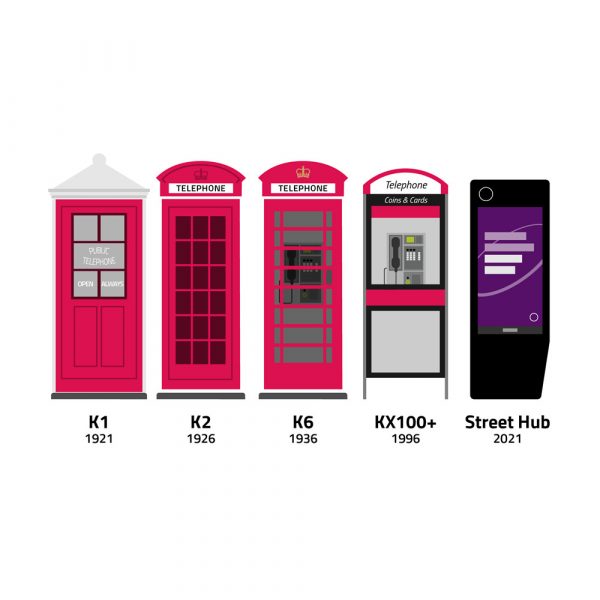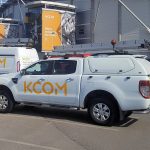Ofcom Moves to Protect Essential UK BT and KCOM Phone Boxes

Ofcom has today introduced new rules to protect public UK phone boxes (payphones) – specifically those built by BT and KCOM – when they exist in areas with “poor mobile signals or high accident rates“. In addition, payphones will now require battery backup so that they can keep working after going digital (all-IP).
At present, there are currently around 20,000 UK payphone boxes still in operation, which is down sharply from the 92,000 that BT alone once had at its peak. Similarly, there has been a steep decline in calls made from such boxes, falling from 800 million minutes in 2002 to just 4 million in 2021/22.
However, BT has spent the past few years decommissioning many of their payphones, most of which were no longer being used, which is largely due to improvements in mobile phone coverage and related service affordability. Some of those have been replaced by BT’s new smart WiFi Street Hub kiosks (mostly in busy urban areas), while around 6,000 others have been adopted by local authorities for other purposes (e.g. turning them into WiFi hotspots or storage for life-saving public defibrillators etc.).
Advertisement
Despite all this, some payphones still exist in areas where they’re needed, and Ofcom has today updated their Telephony Universal Service Obligation (TUSO) to ensure that they stay that way.
Phone boxes will now be protected where:
➤ they are in a place without coverage from all four mobile network providers; or
➤ they are located in an area with a high frequency of accidents or suicides; or
➤ 52 or more calls have been made from them over the past 12 months; or
➤ there is other evidence that a phone box is reasonably needed at a site – for example, where it is being used to make calls to helplines such as Childline.
Ofcom previously estimated that around 5,000 phone boxes would be covered by these protections. However, given the ongoing decline in call volumes and improvements to mobile coverage, they now expect some of these may no longer require protection, although their more recent mobile coverage data indicates that at least 1,400 boxes still lack good mobile coverage.
BT and KCOM must also still consult with local authorities on the removal of boxes that are the last remaining in an area. But those aren’t the only changes.
Ofcom’s Key TUSO Changes for 2022
Strengthened rules to ensure that public call boxes that are still needed are protected from removal.
Previously, local authorities were able to veto the removal of the last public call box in an area, but we are concerned that this veto was applied inconsistently across the UK. We have replaced the veto with a clear, consistent set of criteria which should protect those boxes that are most needed from removal (such as those in areas without full mobile coverage), while also allowing the removal of boxes that are no longer needed. BT and KCOM must still consult with local authorities on the removal of boxes that are the last in an area.
Providing more flexibility on the services provided by public call boxes.
BT offers a range of other on-street devices that provide services such as free calls, phone charging and free Wi-Fi – but these devices do not currently count as public call boxes. To better reflect users’ ongoing needs, and support BT and KCOM in offering improved services to users, we have amended our rules to allow greater flexibility in the services offered from public call boxes. This includes allowing all calls to be free and removing the requirement to offer incoming calls (where all outgoing calls are free).
Ensuring that public call boxes continue to work in the event of a power cut.
Currently, public call boxes can still be used to make calls when there is a power cut in the area. To ensure this continues after networks are migrated to IP, public call boxes will need new battery equipment installed. We have made changes to require BT and KCOM to make sure public call boxes that are likely to be needed in the event of a power cut have batteries installed so they can still be used to make emergency calls for at least three hours.
In addition, Ofcom has also removed the requirement for payphones to offer calls to premium rate and international numbers. The old requirement for 70% of such phone boxes to take cash has also been scrapped, and instead requires BT and KCOM to reasonably assess whether there is a continuing need for using cash in such boxes before they remove any cash payment facilities.
Advertisement
Selina Chadha, Ofcom’s Director of Connectivity, said:
“You may think of a phone box as a local landmark, or as a landmark symbol of British nostalgia. But they can still serve as a vital lifeline – perhaps to call a helpline or the emergency services – when no other options are available.
Our new rules will ensure that many thousands of phone boxes will be protected for as long as they are needed, as well as supporting the rollout of new street hubs, with free Wi-Fi and charging for people on the go.”
Ofcom has also set out their view that it would be “appropriate to remove the requirement to provide fax services from the USO“, which will require an amendment to the legislation by the UK Government (they’re currently said to be “considering whether to make this change“).
This is hardly surprising since the move to all-IP (Internet Protocol) based phone services (VoIP etc.) will hamper how the old analogue FAX system operates (i.e. it can still work, but the timing and synchronisation that fax relies on for the duration of the transmission will not be guaranteed). Perhaps surprisingly, some people and companies do still use it (e.g. the legal, medical and travel sectors).
Mark is a professional technology writer, IT consultant and computer engineer from Dorset (England), he also founded ISPreview in 1999 and enjoys analysing the latest telecoms and broadband developments. Find me on X (Twitter), Mastodon, Facebook, BlueSky, Threads.net and Linkedin.
« ASA Ban Sky Mobile UK Ads for Misleading Perfect Network Claim






















































Given that the Street Hubs do not charge for call to non-premium UK numbers and mobiles, and the revenue from most phone boxes is already fairly paltry, it would make sense for the USO to require USO boxes to also offer free calls (and maybe free WiFi).
Allowing the remaining boxes to also be locations for defib units (under local schemes) would also make sense.
But this is OfCom we are talking about
‘Allowing the remaining boxes to also be locations for defib units (under local schemes) would also make sense.
But this is OfCom we are talking about’
https://business.bt.com/campaigns/communities/adopt-a-kiosk/
Tad redundant regulating to force something already being done voluntarily.
10 years too late
Pay phones will assume a new role when all ip services start in an area. They will be required for their ability to provide service during a power cut and will be in demand from those people who have no back up power in their homes.
Any assumptions that the above scenario is unlikely have been made invalid by the recent announcement that the government have plans in place to implement possible rota power cuts from next January.
It is a shame to see a lot of the old red boxes go, I realise that they are not used so much these days and were a right pain for disabled people to use, but they are part of our history, our culture, just like the old red post box. I also realise that they cost money to maintain.
The one that was around the corner when I moved in 20 years ago have gone now, I think the one up the road from where i live with my parents have gone as well. Fond memories of going there to phone friends as I was not allowed to use the home phone due to it being put in by my brother as he ran a mobile disco.
That’s why BT offer boxes for £1 to the local communities, so they can keep the look of the village. The go for £1000s on ebay, so this is a good offer. Shame some communities don’t take up the offer.
I’ve seen some really creative uses of them for sure, Mick.
I can’t say I feel the same nostalgia for them, our streets are increasingly congested with furniture and a bit less of it can be a good thing, but things like tiny gardens, book exchanges and charity drop-off points have made good use of them.
The more modern, functional ones with less utility should meet their maker.
K1 current state of the internet in the UK
State of your Internet perhaps.
Country as a whole is seeing excellent progress as billions are being poured into upgrading us.
Shame the picture missed out the K8. Not many left now (possibly none at all). Anyone know of one left?
A large driver of the boxes disappearing was a previous rule put in place by Ofcom that all of BT and Kcom’s public telephones must be profitable. This was to prevent them undercutting the rival pay phone operators who sprung up before the rise of the cellphone and putting them out of business.
I like the look and feel of the older phone boxes, but it seems like hardly anyone ever uses them now.
Personally, if the phone box is in an area of poor phone coverage, they should instead be turned into mobile phone repeaters/transmitters so that there is a mobile phone signal from all 4 networks. This would be much more useful than a phone box that no one uses.
In cities and towns I would be upgrading them all to the Street Hub, which includes superfast BT Wi-Fi. The street hubs could also get EE/BT mobile transmitters (like small cells) for additional capacity and coverage in such areas.